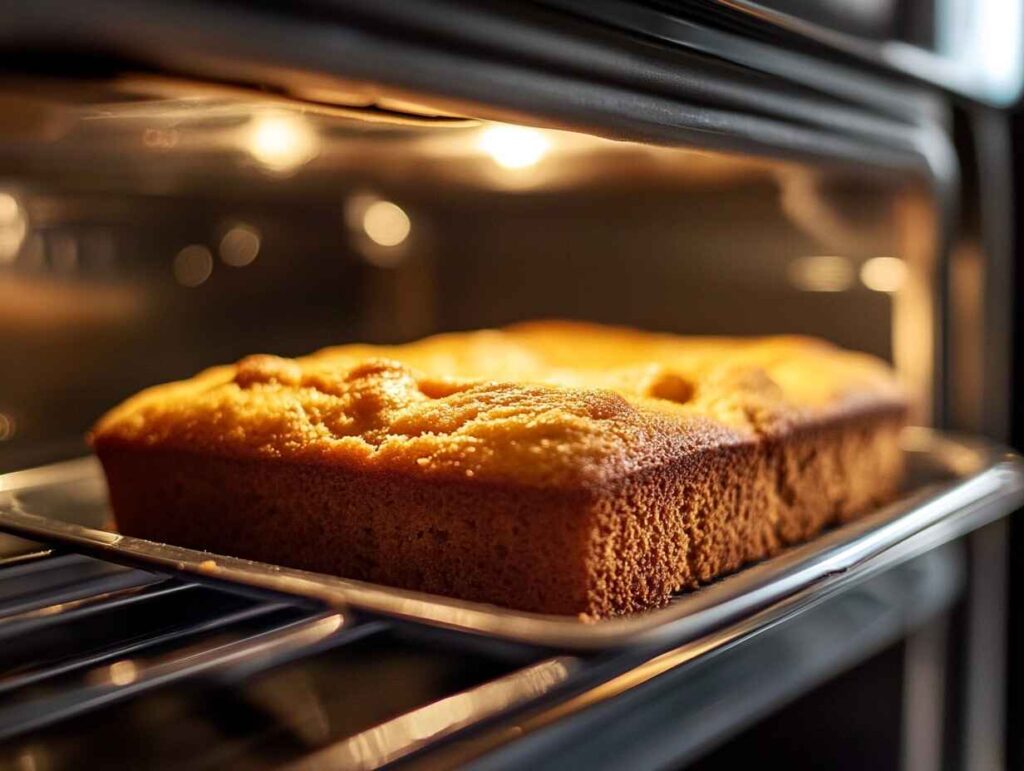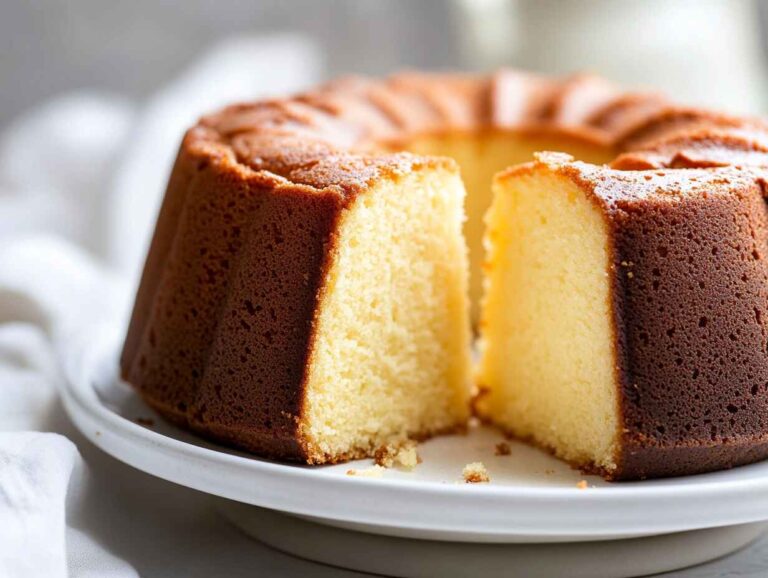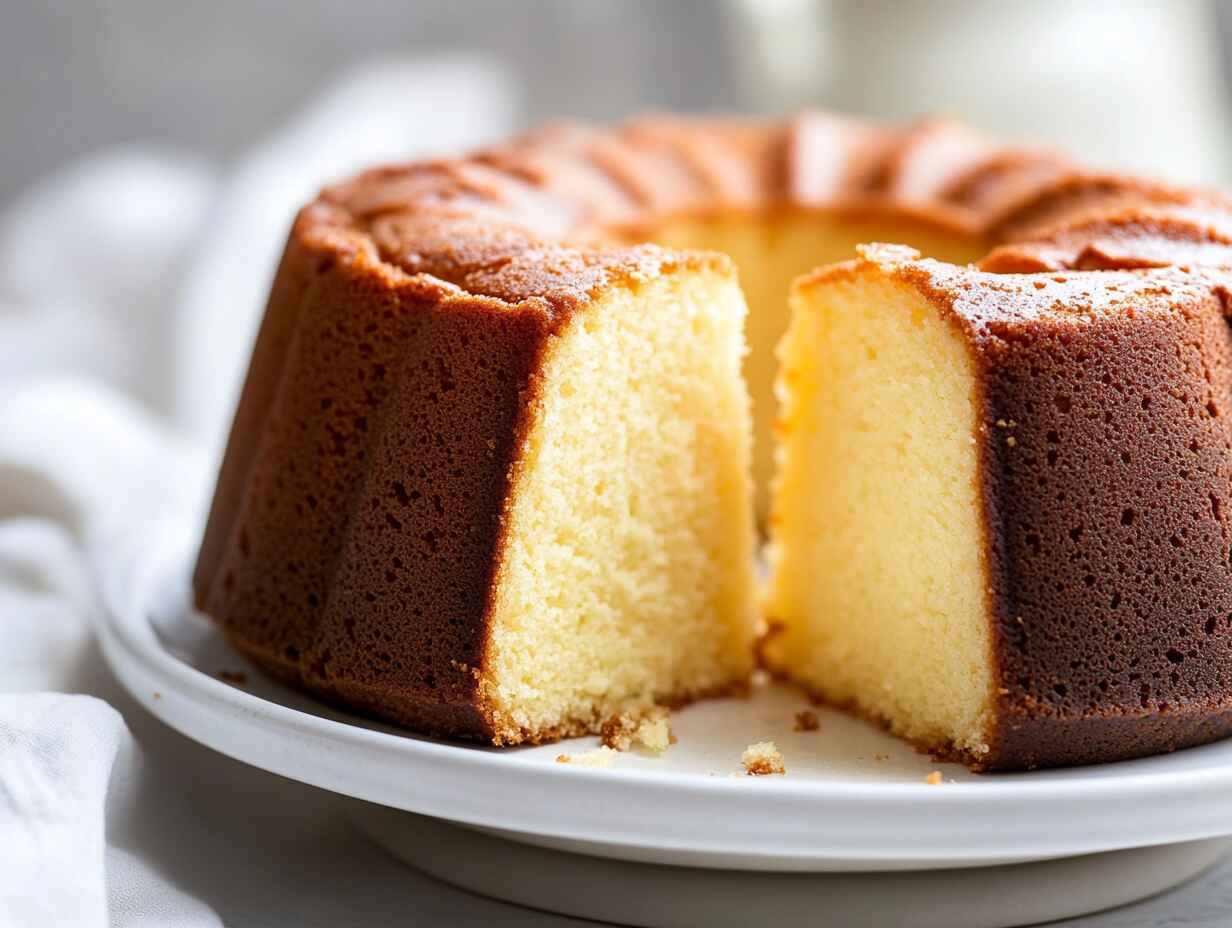Have you ever spent hours baking a pound cake, only to be disappointed with the results? Dense, cracked tops or uneven textures can be frustrating, especially when you’re looking for that perfect, tender crumb. We’ve all been there, but what if I told you there’s a simple secret to getting that flawless pound cake every time?
Imagine this: A lighter, fluffier, and perfectly risen pound cake, with a golden, evenly baked crust, all without the stress of cracking or uneven cooking. This isn’t a baking dream it’s the reality you can achieve with the cold oven method! Why a cold oven is the secret to a better pound cake lies in how this simple yet powerful technique transforms the way your cake rises and bakes, ensuring an even, delicious result. Over time, variations like this rich and buttery chocolate pound cake recipe have emerged, offering new takes on this classic.
Table of Contents
The Role of the Oven in Baking Pound Cake
In the world of baking, your oven is your most important tool. But it’s not just about making sure it’s hot enough how heat is applied is just as crucial. Pound cakes, with their unique texture and rich flavor, require a gentle, even heat to achieve that perfect crumb. But when it comes to temperature, too much or too little can cause major issues. So, how does the oven come into play?
How the Oven Temperature Affects the Texture and Crumb
Every cake, including pound cakes, relies on heat to perform a magical transformation. Heat is what causes the ingredients to react, allowing the cake to rise and form its texture. However, why a cold oven is the secret to a better pound cake lies in how the heat is applied during the baking process, significantly impacting the cake’s final texture.
When you preheat your oven, the temperature inside the oven is uniform from the start, meaning that the cake batter is immediately exposed to higher temperatures. This can cause the outside of the cake to cook faster than the inside, leading to a thicker crust and a denser, sometimes even dry, crumb. This uneven cooking often leads to cracks and a less-than-ideal texture. In contrast, using the cold oven method for baking pound cakes ensures a gentler, more gradual rise, producing a tender, even crumb.
Why Preheating Isn’t Always the Best Option for Pound Cake
Traditionally, bakers have always been told to preheat their ovens before putting their cakes in, and for many types of baking, this is absolutely necessary. However, when it comes to pound cakes, this advice doesn’t always work in your favor. Why a cold oven is the secret to a better pound cake lies in how it avoids the common pitfalls of preheating, ensuring a flawless baking process.
One reason for this is that the traditional preheating method exposes the cake batter to intense heat from the very beginning, which could lead to the outer parts of the cake cooking too quickly. For pound cakes, this can create an overly thick crust and prevent the inside of the cake from rising properly. The cake can become overly dense or crack as it rises unevenly. In contrast, starting with a cold oven for your pound cake allows for more gradual heat distribution, which leads to a gentler rise and a smoother, more uniform texture.
The Cold Oven Method: What Does It Mean?
So, what exactly is the cold oven method, and how does it differ from conventional baking techniques? Simply put, why a cold oven is the secret to a better pound cake lies in its simplicity and effectiveness. Baking with a cold oven means that you don’t preheat your oven before placing your cake inside. You put the cake batter into a cold oven, then set the oven to the desired baking temperature. As the oven heats up, so does your cake batter, allowing for a gentler, more even rise. It’s that simple!

How to Bake a Pound Cake with a Cold Oven
Here’s how you can bake a perfect pound cake using the cold oven method:
- Prepare your ingredients: Make sure all your ingredients are at room temperature this includes butter, eggs, and milk. Cold ingredients can affect the texture of the cake.
- Mix your batter: Follow your pound cake recipe to prepare the batter. Be sure not to overmix, as this can result in a dense cake.
- Prepare your pan: Grease and flour your cake pan or use parchment paper to prevent sticking.
- Place the batter in the pan: Pour the prepared batter into the pan, making sure it’s evenly spread.
- Set the oven to the desired temperature: For most pound cake recipes, this will be around 325°F (163°C). Place the pan in the cold oven.
- Start baking: Turn the oven on to the desired temperature. The oven will gradually heat up, and your cake will begin to bake as the temperature rises.
- Check the cake: Bake for the recommended time, usually between 60 to 90 minutes. Check for doneness by inserting a toothpick into the center of the cake if it comes out clean, the cake is done!
The Process of Gradual Heating and Its Impact on the Cake
The beauty of the cold oven method lies in the slow and steady rise of the cake. As the oven heats up gradually, the batter has time to expand without sudden temperature shifts. This gives the cake a better chance to rise evenly, creating a light and tender crumb. It also helps the cake to bake more evenly, reducing the chances of overcooking the outside while leaving the inside raw.
By starting from a cold oven, the batter doesn’t experience the same shock as it would with a preheated oven, allowing it to bake more gently. This can be particularly beneficial for pound cakes, which need that delicate balance of tenderness and structure.
Common Problems When Baking Pound Cake and How to Solve Them
Even seasoned bakers encounter issues like dense textures, cracks, or dryness. For example, understanding why your chocolate pound cake may turn out dry can help troubleshoot common pitfalls.
Problem 1: Dense, Heavy Pound Cake
One of the most common complaints about pound cakes is that they turn out dense or heavy. No one wants a thick, overly compact cake especially when you’re aiming for a light, tender crumb. So, what causes this? There are a few possible reasons:
- Overmixing the batter can result in too much air being incorporated, which leads to a denser texture.
- Using cold ingredients can cause the batter to not mix properly, leading to a heavier cake.
- Baking the cake in a hot oven can cause the outer parts to cook too quickly, leaving the inside dense and undercooked.
Solution: By using the cold oven method, you’re allowing the cake to rise more slowly and evenly. The gradual heat distribution ensures that the batter is given enough time to rise without the outer edges cooking too quickly, which can help create a lighter texture. Additionally, be sure to measure your ingredients correctly and avoid overmixing the batter to keep things light and airy.
Problem 2: Cracked Tops or Uneven Rising
If you’ve ever baked a pound cake and found it had cracks running down the top, you know how disappointing it can be. A cracked top can result from the cake rising too quickly in certain areas, which creates tension in the structure and causes cracks to form.
Solution: The cold oven method can help prevent this problem. Since the cake rises slowly and evenly as the oven gradually heats up, there’s less chance of the cake rising too quickly and cracking. By the time the oven reaches its full temperature, the cake has had enough time to adjust and rise evenly, creating a smooth, crack-free top.
Problem 3: Overcooked or Undercooked Pound Cake
No one likes an overcooked or undercooked cake. An overcooked pound cake becomes dry and crumbly, while an undercooked one can be raw in the center, making it impossible to enjoy. So, what causes these problems? Well, it all comes down to heat and timing.
When using a preheated oven, the cake might cook unevenly often with the edges overcooking while the middle remains raw. This is especially common with dense batters like pound cakes.
Solution: The cold oven method helps solve this problem by allowing the cake to heat up slowly and evenly. As the oven gradually reaches its target temperature, the batter rises gently, ensuring the cake is baked uniformly from the edges to the center. No more worrying about that raw middle or dry, tough edges!
How to Check for Doneness:
The best way to check if your pound cake is fully baked is by using the toothpick method. Insert a toothpick or cake tester into the center of the cake. If it comes out clean or with just a few moist crumbs attached, your cake is done. If it comes out wet with batter, give it more time in the oven, but be sure to check every 5–10 minutes to avoid overcooking.
Why the Cold Oven Method Works: The Science Behind It
By now, you might be curious about why the cold oven method works so well. Is it just a trick, or is there actual science behind it? The answer is simple: it’s all about gradual heating, even distribution of heat, and how the batter responds to it.
The Effect of Gradual Heating on Cake Rise and Texture
Why a cold oven is the secret to a better pound cake? When you place your cake in a cold oven, the gradual rise of the temperature gives the batter time to expand evenly. This slow process prevents the outer edges from cooking too quickly and allows the center to catch up. As the batter heats up, air bubbles trapped inside begin to expand, causing the cake to rise. The slower the heat increases, the more evenly the cake will rise, resulting in a tender, light crumb and an even texture.
In contrast, when you place the cake in a preheated oven, the initial exposure to high heat causes the outer edges to cook faster than the center. This results in an uneven rise and can lead to dense spots in the cake. Why a cold oven is the secret to a better pound cake lies in how this method prevents these issues, giving the batter more time to adjust to the increasing temperature, resulting in a much more consistent rise and texture.
How a Cold Oven Affects the Maillard Reaction and Crust Formation
Another factor that makes the cold oven method so effective is the Maillard reaction. This is the chemical process that gives baked goods, including cakes, their golden-brown color and delicious flavor. The Maillard reaction begins to occur around 300°F (150°C), but it takes time to develop fully.
Why a cold oven is the secret to a better pound cake lies in how this gradual heating allows the Maillard reaction to take place more effectively. When the cake starts baking in a cold oven, the Maillard reaction has more time to develop as the oven gradually heats up. This creates a more even and well-developed crust, giving your pound cake a beautiful color and flavor. On the other hand, a preheated oven can cause the outer crust to form too quickly, preventing the Maillard reaction from developing properly and potentially resulting in a less flavorful crust.
Tips for Perfecting Your Pound Cake Using the Cold Oven Method
If you’re ready to try the cold oven method for yourself, there are a few tips that can help you perfect your pound cake. With these simple tricks, you’ll be baking like a pro in no time! For additional tips, learn how to keep your pound cake moist with proven methods.
Essential Tools and Ingredients for a Successful Pound Cake
Before diving into the cold oven method, make sure you have everything you need for the perfect pound cake. Here are some essentials:
- Quality ingredients: Always use fresh, high-quality butter, eggs, flour, and sugar for the best results.
- Room temperature ingredients: Make sure your butter and eggs are at room temperature to ensure proper mixing.
- Measuring cups and spoons: Accurate measurements are key to getting the right texture.
- Proper baking pan: Use a 9-inch round or loaf pan, which works best for pound cakes.
Step-by-Step Guide to Baking a Pound Cake with a Cold Oven
Here’s a simple, step-by-step guide to help you get started with the cold oven method:
- Gather all your ingredients and bring them to room temperature.
- Grease and flour your baking pan or line it with parchment paper.
- Prepare your batter as usual, taking care not to overmix.
- Place the batter in the prepared pan.
- Put the pan in the cold oven and set the temperature to 325°F (163°C).
- Bake for 60–90 minutes, checking for doneness with the toothpick method.
- Allow the cake to cool completely before removing it from the pan.
Enjoying Your Perfect Pound Cake and Experimenting with Variations

Once you’ve mastered the cold oven method, it’s time to get creative with your pound cake recipes! You can experiment with different flavors, like adding vanilla, almond extract, or lemon zest to the batter. You can even mix in berries, nuts, or chocolate chips to create your own signature pound cake.
Here are a few variations to try:
- Lemon Pound Cake: Add the zest and juice of one lemon for a fresh, zesty twist.
- Almond Pound Cake: Add almond extract for a nutty flavor that pairs perfectly with a light glaze.
- Chocolate Chip Pound Cake: Fold in some mini chocolate chips for a rich and decadent treat.
- Blueberry Pound Cake: Add fresh blueberries to the batter for a fruity and colorful version of this classic cake.
- A chocolate bundt cake: is a delicious and rich dessert that combines the moist texture of a cake with the deep flavor of chocolate.
FAQ : Why a Cold Oven is the Secret to a Better Pound Cake?
What is the cold oven method for baking a pound cake?
The cold oven method involves placing the pound cake batter into a cold oven and then turning it on to the desired temperature. As the oven heats up, the cake bakes gradually, resulting in a more even rise and texture.
Why is the cold oven method better than preheating the oven?
Preheating the oven can cause the outer edges of the cake to cook too quickly, leading to uneven rising, cracks, or a dense texture. The cold oven method allows for gradual heating, which gives the cake more time to rise evenly and ensures a tender, light crumb.
Does the cold oven method work for all types of cakes?
While the cold oven method works particularly well for pound cakes due to their dense texture, it might not be suitable for all types of cakes. Lighter cakes, like sponge cakes, often require a preheated oven to achieve the best results.
Conclusion: Why a cold oven is the secret to a better pound cake?
If you’ve ever struggled with dense, cracked, or uneven pound cakes, it’s time to give the cold oven method a try. Why a cold oven is the secret to a better pound cake lies in how it gradually heats the batter, allowing for a perfect rise and a smooth texture. By taking the time to gradually heat the oven, you can create a cake with a perfect crumb and a beautifully even rise. No more worrying about undercooked centers or overcooked edges just a perfectly baked pound cake every time!
Print
Why a cold oven is the secret to a better pound cake?
Baking a pound cake in a cold oven is a unique technique that results in a moist, evenly baked cake with a fine crumb. Unlike traditional baking methods that require preheating, this method allows the cake to rise gradually, leading to a tender texture. Here’s a step-by-step guide:
- Total Time: 1 hour 35 minutes
- Yield: 12 slices
Ingredients
- 3 cups (360g) all-purpose flour
- 3 cups (600g) granulated sugar
- 6 large eggs, room temperature
- 1 cup (226g) unsalted butter, softened
- 1 cup (240ml) whole milk, room temperature
- 2 teaspoons vanilla extract
- 1/2 teaspoon salt
- 1/2 teaspoon baking powder (optional, for a slightly lighter texture)
Instructions
Prepare the Batter:
In a large bowl, cream the butter and sugar together until light and fluffy. Add the eggs one at a time, beating well after each addition.Incorporate Dry Ingredients:
In a separate bowl, whisk together the flour, salt, and baking powder (if using). Gradually add the dry ingredients to the butter mixture, alternating with milk. Begin and end with the flour mixture. Stir in the vanilla extract.Grease the Pan:
Generously grease and flour a 10-inch (12-cup) Bundt or tube pan to prevent sticking.Pour Batter into the Pan:
Evenly spread the batter into the prepared pan, smoothing the top with a spatula.Start in a Cold Oven:
Place the cake in the cold oven, then set the temperature to 325°F (163°C). Avoid opening the oven door during baking.Bake Until Done:
Bake for 1 hour and 10 minutes to 1 hour and 30 minutes, or until a toothpick inserted in the center comes out clean.Cool the Cake:
Let the cake cool in the pan for 15 minutes, then invert onto a wire rack to cool completely.
Notes
A 10-inch Bundt or tube pan works best for this recipe, as it allows for even heat distribution. Avoid using dark-colored pans, as they can cause overbrowning.
Beating the butter and sugar together until fluffy helps incorporate air, contributing to the light texture of the cake.
A 10-inch Bundt or tube pan works best for this recipe, as it allows for even heat distribution. Avoid using dark-colored pans, as they can cause overbrowning.
- Prep Time: 20 minutes
- Cook Time: 1 hour 15 minutes
- Category: Dessert
- Method: Baking
- Cuisine: Southern, American
Remember, baking is an art and a science, and the cold oven method is a simple yet powerful tool that can help you achieve bakery-quality results at home. Whether you’re baking for a special occasion or just because you want to treat yourself, this technique will help you bake pound cakes like a pro.

